Canker Rots and The Heart Rot Myth
By Alex L. Shigo
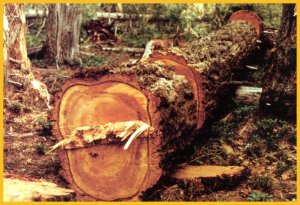 Ring rots,
when they are canker rots, are major causes of defect and loss of value
in Douglas fir, as shown here, and in other conifers.
Ring rots,
when they are canker rots, are major causes of defect and loss of value
in Douglas fir, as shown here, and in other conifers.
Canker rots: I think I know what they are. But heart
rots? I don't know what they are. The fungi associated with canker
rots produce wedge-like structures into the bark. The wedges then
squeeze and eventually cause the death of the cambial zone. In a
sense, it is as if the tree is being rewounded periodically.
Heartwood, heart rot confusion
Heart rots are defined as the rot of the heartwood in trees. It
is implied that all trees have heartwood, which is supposed to be the dead
non-responsive central core wood of all trees. Further, the heartwood
is thought to be darker in color than the sapwood. The subject gets
increasingly more confusing as you wade through the literature, as I have
done. The major problem comes when wood that has discolored following
wounding is called a type of heartwood: wound heartwood, pathological heartwood,
precocious heartwood. The confusion increases as you search to find
a definition of heartwood. When trees that do not have heartwood
are used in studies that compare heartwood with discolored wood in the
same tree, then it is time to give up or try to bring some sense to all
of this. It has been at least 30 years since I started writing and
speaking out about this confusion in highly technical and non-technical
journals and meetings. When I see new textbooks and hear some teachers,
I know that very little clarification has come over the years. Science
is supposed to advance as new ideas are presented and as old ideas are
reconsidered and adjusted when necessary. Wood in living trees is
a highly ordered arrangement of cells that are all alive when first formed
by the cambial zone. In time, some cells age and die and function
for transport and support. Other cells live longer and serve as storage
spaces for energy reserves and spaces for bodies that carry out the essential
processes of life.
 The fungus
wedges associated with the canker rot fungus developed deep inside this
oak. The wedges keep the wood open.
The fungus
wedges associated with the canker rot fungus developed deep inside this
oak. The wedges keep the wood open.
Is wood really dead?
A poor understanding of wood in living trees is a major part of the
confusion. The great mass or size of trees is the next problem.
To study wood, small pieces were taken into a laboratory and examined under
the microscope. Wood anatomy was born; not tree anatomy! The information
was valuable because products from wood were so important to economics.
Further, because wood products were dead, and wood under the microscope
was dead, soon wood was considered as a dead substance in living trees.
Remember, in the laboratory the wood was fixed -killed and prepared -before
being sliced for observation under the microscope. Forest products
interests for economic reasons was so high because forests were thought
to be endless. Products research and university studies and research
on wood products were the major activities associated with trees.
Tree biology never had a chance.
Trees are living organisms! As living systems, trees do respond
in order to survive when their survival is threatened. So simple.
So extremely difficult to get accepted! Why? Because if you
accept this simple fact then you must throw out mountains of data and treatments
- really myths - based on trees that have dead wood.
Telescopes and chain saws: research tools
Canker rots is the subject, but to understand the subject, it is necessary
to understand why there has been a problem. Canker rots have been
and still are called the "true heart rots." They are called such
because they appear to not fit the patterns of compartmentalization.
I am very familiar with this problem. Some of my dear old research
friends of years past did accept parts - but not all- of the compartmentalization
theory. They still reserved the "right" to say that there are "true
heart rots." The true heart rots do spread beyond boundaries, they
said. And, they did, as easily seen on cross-sections of logs. Today
there are still many people who believe in true heart rots. Galileo
said his critics would not look through his telescope. My critics
will not dissect living trees. (It's great to think that the chain
saw is in the same league as the telescope!) Still. Do these
"true heart rots" spread beyond boundaries? No! These rots
follow the theory of compartmentalization exactly, but to recognize this
you must not only dissect trees but also understand compartmentalization.
Every time a living tree is wounded it will respond by first forming chemical
boundaries and later anatomical boundaries, but boundaries to resist spread
will begin to form as long as there are stored energy reserves.
Canker rots are caused by fungi that have the genetic ability to
produce wedges into bark. As the fungus wedges spread into the bark
they "squeeze" the cambium zone from the outside inward. In time
the cambial zone under the wedge wanes and dies. It is the same as
a new wound. Then the struggle starts as the fungus "attempts" to
grow into the newly declining wood tissues and the tree begins to respond
in ways that resist spread.
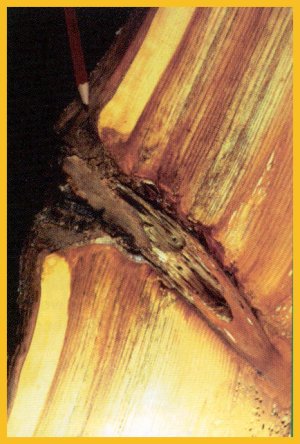 Canker
rots are caused by fungi that form wedges into the bark, as shown by the
pencil point in this eastern white pine. The fungi infect the resign-soaked
wood and the branch corewood.
Canker
rots are caused by fungi that form wedges into the bark, as shown by the
pencil point in this eastern white pine. The fungi infect the resign-soaked
wood and the branch corewood.
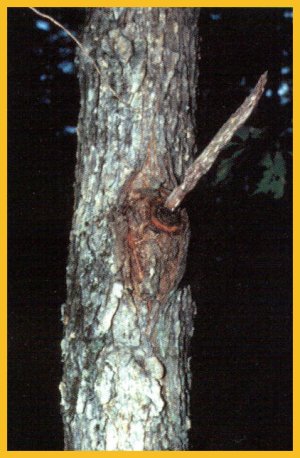 On species
of birch and maple (shown here), canker rot fungi produce hard masses of
tissue that prevent the wounds from closing. The sexual stages of
the fungi do not form until the tree dies.
On species
of birch and maple (shown here), canker rot fungi produce hard masses of
tissue that prevent the wounds from closing. The sexual stages of
the fungi do not form until the tree dies.
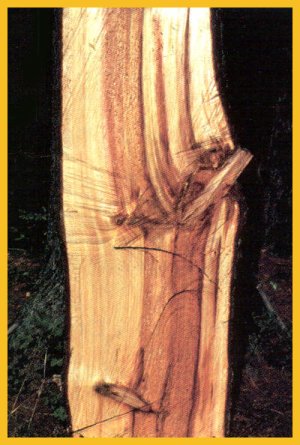 The heart
rot concept cannot explain the patterns of decayed wood associated with
canker rot fungi. This dissection of an eastern white pine shows
sound wood between columns of decayed wood. The heartrot concept
is wrong and must be put to rest!
The heart
rot concept cannot explain the patterns of decayed wood associated with
canker rot fungi. This dissection of an eastern white pine shows
sound wood between columns of decayed wood. The heartrot concept
is wrong and must be put to rest!
Ring rots and canker rots
One type of canker rots, called ring rots, go a few steps beyond
in their attack. These rot-causing fungi grow best in wood tissues
that have been altered chemically as part of the tree's defense.
This is best seen in conifers and Eucalyptus species. I call this
action "don't throw me in the briar patch." Remember in the Uncle
Remus story where the Brer Fox caught the rabbit and wanted to be as mean
as possible to the rabbit? The rabbit said to Brer Fox, do anything
to me, but please don't throw me in the briar patch. The fox, thinking
this was the worst thing he could do to the rabbit, quickly threw the rabbit
into the briar patch. You know the rest of the story. In a
sense the same actions happen here. The fungus "says" please don't
form those awful defense chemicals, and the tree does. Then the fungus
grows rapidly only in the wood that has the defense chemicals. No
competition! The chemicals can only be formed in wood that still
contains some living cells. The "rings" as seen on the cross-cut
surface of logs then show the rot patterns that followed the tree defense.
If all of this is so, why doesn't the tree die? Simple. Time.
It takes time for all of the tree response actions to take place, and it
takes time for the fungus to spread. While time is going by, the
tree (as a generating system) forms new cells in new spatial positions.
So, we have a sort of seesaw going on as the tree responds, the fungus
wedges form, the wood dies, the fungus spreads, and new tissues form.
Because all these events do take time, both the fungi and the tree benefit.
It is difficult for many people to understand the ways natural systems
work where two "teams" are "playing" against each other, and both teams
win! Trying to explain dualities goes far beyond the scope of this
discussion. You either accept them or you don't!
Armillaria spp. are canker rots
Armillaria species that incite rots of woody roots are canker rots.
The fungi produce wedges into the root bark and thus keep expanding the
volume of rot. As the rot spreads, tissues that would normally store
energy reserves decrease in volume. A major function of woody roots
is energy storage. As storage decreases because of decreasing space,
a time comes when defense also begins to decrease. When defense,
which requires energy, decreases, compartmentalization also begins to weaken.
As compartmentalization weakens, the pathogen spreads faster. When
compartmentalization no longer functions, the tree part, or the entire
tree, dies.
Heart rot or center rot
Back to old-fashioned heart rot. Again, heart rot is defined as
the rot of the heartwood. Further, it was believed that all trees
have heartwood, and that heartwood is dead wood, and that the heart or
center of all trees is dead, and therefore back to all trees have heartwood.
This is a perfect example of circle thinking that starts and finishes on
premises that are thought to be correct, but really are not. First,
all trees do not have heartwood. Heartwood does not have living cells,
yet heartwood will discolor further or form boundaries when wounded.
Next, central rots were common because trees have branches! As branches
died and stubs were infected, the pathway was always to the center of the
tree. Heart rots or center rots were common long before machines
went into the forest! So-called saprots were rare because machine-caused
wounding was rare. That has all changed in the last century, but
the confusion started long before the last century.
If all of this is so, and it is so simple to understand the truth,
why was the truth not known long before this? Mainly because forests
were thought to be endless, and that the major problems facing humans were
problems of products. Trees were everywhere. Why worry about mere
trees?
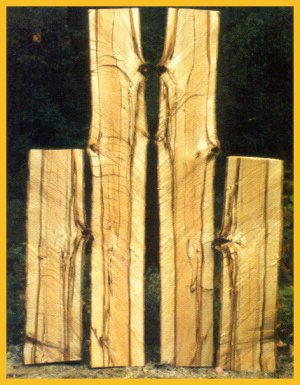 Canker
rots are common in species of poplar, as shown here. Branch stubs
are the usual infection courts. To understand canker rots, cross sections
and longitudinal sections must be studied.
Canker
rots are common in species of poplar, as shown here. Branch stubs
are the usual infection courts. To understand canker rots, cross sections
and longitudinal sections must be studied.
Tree biology still has acceptance problems
As a young researcher, I went to wood meetings all over the world.
Those meetings were all aimed at products, not living trees. It is
difficult to believe that tree biology is "a new kid on the block."
You will never learn about living things by studying dead things, or by
calling living things by names that belong to dead things!
Canker rots are all too common. Ring rots are the most economically
damaging
defects in pine. Fomes pini and its variants have been called the
most economically damaging fungi in the world. Of interest is the
damage caused by ring rots and canker rots in Eucalyptus species.
This fact is still not accepted. In 1980, I tried to publish a paper on
compartmentalization in Eucalyptus species in Australia. The proposed
paper was shot down in ways that made it impossible to fly again.
The real problem there was not the acceptance of compartmentalization,
but rather the fact that if they did, they would have to accept the cause
- fire wounds.
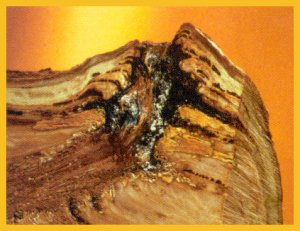 Canker
rots are common in many species of eucalyptus. Note the broken branch
stub and the bands of decayed wood separated by sound wood in this eucalyptus
species.
Canker
rots are common in many species of eucalyptus. Note the broken branch
stub and the bands of decayed wood separated by sound wood in this eucalyptus
species.
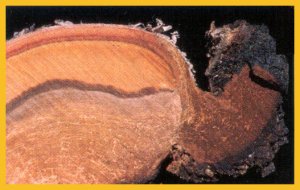 Note
the wedge formed by the canker rot fungus in the bark of this birch.
As the cambial zone is squeezed to death, the tissues beneath it are killed
and invaded by the canker rot fungus.
Note
the wedge formed by the canker rot fungus in the bark of this birch.
As the cambial zone is squeezed to death, the tissues beneath it are killed
and invaded by the canker rot fungus.
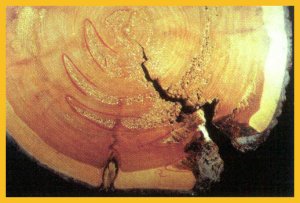 Five rings
of decayed wood are in this section of an eastern white pine. The
fungus infects wood formed by the tree in response to the infection.
Five rings
of decayed wood are in this section of an eastern white pine. The
fungus infects wood formed by the tree in response to the infection.
Know your marketplace!
Why do arborists need to know this stuff? The quick answer is
to enable them to make better decisions faster. When more tree decisions
are made better and faster, everybody wins, especially the tree.
Information is power. We hear it every day. We see decisions
being made that affect every phase of our lives. I believe every
arborist needs to know some history, some biology, and some facts about
our modern marketplace. People who hire arborists to provide a service
demand that the service be better, faster, and less expensive than in the
past. The marketplace is the cornerstone of the business world.
Enough.
What should be done?
Once a canker rot is identified, the defect will only get worse.
Trees do have ways to slow the process. The seesaw does go both ways.
The pathogen gains some space and then the tree strengthens the newly injured
area by producing not only more wood in the area of injury, but a type
of wood that is much stronger than normal wood. The wood is woundwood.
Woundwood is wood that forms about an injured area. The wood differs
from, normal wood in that it has more lignin and the cell types and arrangements
are such that they favor long-term support. That is the good news.
The not-so-good news is that woundwood is very "expensive."
Here we go back again to the benefits of health. And with health
we go back to energy reserves. A tree that has high amounts of energy
reserves will be able to form ribs of strong woundwood. A sick tree
or tree under any kind of stress will not. We cannot get away from
stress, health and energy. The arborist who understands this will
treat all trees, including those with canker rots and other injuries, in
ways that will increase health and energy reserves and decrease stress.
Easy to say. Not so easy to do. Too often the decision comes
to remove the tree.
How do canker rots start? (Remember, ring rots are types
of canker rots.) Fungi and associates infect wounds and branch stubs
in four basic ways:
1. annual cankers, where a shallow wound is infected and spread is
limited to one growing period;
2. wounds where successions of organisms may or may not cause increasing
columns of compartmentalized discolored and decayed wood;
3. perennial cankers, where wounds and stubs are infected and the
pathogens invade bark first and wood later in a seesaw pattern;
4. canker rots where the organisms infect the wood first and then
move to the bark.
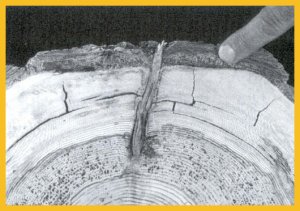 The center
of this fir is sound. A ring of decayed wood surrounds the sound
center wood. Note the wedges formed by the canker rot fungus
in the bark to the sides of the branch stub (finger).
The center
of this fir is sound. A ring of decayed wood surrounds the sound
center wood. Note the wedges formed by the canker rot fungus
in the bark to the sides of the branch stub (finger).
Little is known about the early stages of establishment of the pathogens
that incite canker rots. Here I give you my opinion based on research
and observations. I believe the major infection court is dying, not
dead, branch bases. At this point they may not be seen or recognized
as stubs. I believe further that the most serious type of infection
court, or individual, is one where there are still living cells but low
or no defense system. (Examples with humans are easy to come by.)
Next, at the crotch of branches where the trunk collar and branch collars
meet, there is a gap that has been long recognized for annual plants.
A similar gap occurs in woody plants. Further, for a brief time during
leaf flush, the cells in the gap zone have little bark protection, even
on healthy branches. When this area has stressed or dying cells,
I believe this is the site and the conditions for infections that incite
perennial cankers or canker rots. The major difference between the
two is that with perennial cankers, the pathogens invade the bark first
and later grow only slightly in the wood. With canker rots, the pathogens
infect wood mostly and penetrate the bark only slightly with their wedges.
I have never seen a perennial-type canker that did not have an old branch
stub or branch core wood in the center. Most canker rots follow the
same pattern, but I have seen a few that did obviously start at trunk wounds.
Most canker rots and perennial cankers will be located between the
four to 20 feet above ground level on trunks. Be on alert for them
as you climb. The fungus wedges can be verified by the swollen areas
about old stubs, and by exposing the wedge by cutting into the swollen
area. In conifers, the old branch core wood may be replaced by the
wedge material. Such a wedge is often called a punk knot.
On angiosperms, the swollen areas rarely produce sporophores.
Sporophores may form on some standing trees after they die, but usually
the fertile fruit bodies do not form until the tree is down and in contact
with the ground. The same situation occurs with some perennial cankers,
though not all. A longstanding forestry practice has been to remove
trees with canker rots and to do so in ways that keep infected trunks above
the ground. In arboriculture I am all for the use of attractive trunk
sections for landscaping, but great care must be made never to use
a trunk section that has canker rot.
What about chipping trunks that have canker rots or perennial cankers?
Can chips used for mulch support growth and fruit bodies of pathogens that
incite canker rots or perennial cankers? I am not aware of research
on these questions. I believe that as long as wood only is chipped
there is little or no problem. However, if bark remains on some chips
it is highly possible that perennial canker-causing pathogens could be
disseminated. Perennial cankers commonly have fruit bodies on the
bark about the canker.
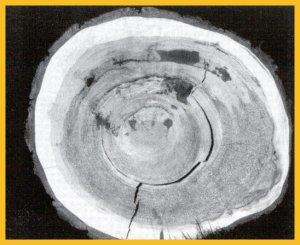 This
section from a Douglas fir is over three feet in diameter. The center
is sound. Rings of decayed wood are separated by sound wood.
The heart rot concept states that heartwood is decayed after wounding.
If this is so, why the sound center of heartwood?
This
section from a Douglas fir is over three feet in diameter. The center
is sound. Rings of decayed wood are separated by sound wood.
The heart rot concept states that heartwood is decayed after wounding.
If this is so, why the sound center of heartwood?
Arborists are providers
Arborists, like other professionals, are providers. They provide
more than services and products that optimize the high quality time for
trees. Arborists should provide information to tree owners.
The information bonds the arborist with the tree owner. Information
connects. Connections - isn't that what it's all about?
Before I end this discussion, let me say a few words about one of
my favorite subjects - myths associated with terms. The subject here
is still canker rots. Let us look closely at this term. A canker
is a localized lesion. A lesion is any dead spot. The lesion
could completely cover an organism. Yet, when the lesion has definite
limits or borders it is called a canker. Next, rot is a term indicating
the breakdown process of wood. Rot is an ongoing or continuous type
of process, or one that is spreading. Now, look at the two words
again. One means confining or limited, and the other means continuing
or spreading. So, now we have a spreading confining term. Such
a term is called an oxymoron. To add more confusion to the subject,
consider the term "sterile conk," given to some canker rots such as those
incited by Inonotus obliquus (Poria obliqua) on species of Betula, and
Poly porus glomeratus on species of Acer. A conk is a fertile fruit
body. So here we have a sterile fertile fruit body. Crazy?
Oxymoron? Yes. No wonder there is confusion.
“An author,
lecturer and consultant, Dr. Shigo started
Shigo and Trees, Associates
twenty
years ago after retirement from the U.S. Forest Service.”
Reproduced with permission of Tree Care Industry and Dr. Alex L.
Shigo.
The article was published in Volume X11, Number 8- August 2001 of
TCI.
This site is dedicated to the remembrance of Robert Felix who for
many years worked very hard for the
improvement of the tree care industry: 1934-1996.
Back to Articles.
Dictionary MAIN
PAGE
Text & Graphics Copyright © 2009
Keslick & Son Modern Arboriculture
Please report web site problems, comments and words of interest,
not found.
Contact
 Ring rots,
when they are canker rots, are major causes of defect and loss of value
in Douglas fir, as shown here, and in other conifers.
Ring rots,
when they are canker rots, are major causes of defect and loss of value
in Douglas fir, as shown here, and in other conifers.
 The fungus
wedges associated with the canker rot fungus developed deep inside this
oak. The wedges keep the wood open.
The fungus
wedges associated with the canker rot fungus developed deep inside this
oak. The wedges keep the wood open.
 Canker
rots are caused by fungi that form wedges into the bark, as shown by the
pencil point in this eastern white pine. The fungi infect the resign-soaked
wood and the branch corewood.
Canker
rots are caused by fungi that form wedges into the bark, as shown by the
pencil point in this eastern white pine. The fungi infect the resign-soaked
wood and the branch corewood.
 On species
of birch and maple (shown here), canker rot fungi produce hard masses of
tissue that prevent the wounds from closing. The sexual stages of
the fungi do not form until the tree dies.
On species
of birch and maple (shown here), canker rot fungi produce hard masses of
tissue that prevent the wounds from closing. The sexual stages of
the fungi do not form until the tree dies.
 The heart
rot concept cannot explain the patterns of decayed wood associated with
canker rot fungi. This dissection of an eastern white pine shows
sound wood between columns of decayed wood. The heartrot concept
is wrong and must be put to rest!
The heart
rot concept cannot explain the patterns of decayed wood associated with
canker rot fungi. This dissection of an eastern white pine shows
sound wood between columns of decayed wood. The heartrot concept
is wrong and must be put to rest!
 Canker
rots are common in species of poplar, as shown here. Branch stubs
are the usual infection courts. To understand canker rots, cross sections
and longitudinal sections must be studied.
Canker
rots are common in species of poplar, as shown here. Branch stubs
are the usual infection courts. To understand canker rots, cross sections
and longitudinal sections must be studied.
 Canker
rots are common in many species of eucalyptus. Note the broken branch
stub and the bands of decayed wood separated by sound wood in this eucalyptus
species.
Canker
rots are common in many species of eucalyptus. Note the broken branch
stub and the bands of decayed wood separated by sound wood in this eucalyptus
species.
 Note
the wedge formed by the canker rot fungus in the bark of this birch.
As the cambial zone is squeezed to death, the tissues beneath it are killed
and invaded by the canker rot fungus.
Note
the wedge formed by the canker rot fungus in the bark of this birch.
As the cambial zone is squeezed to death, the tissues beneath it are killed
and invaded by the canker rot fungus.
 Five rings
of decayed wood are in this section of an eastern white pine. The
fungus infects wood formed by the tree in response to the infection.
Five rings
of decayed wood are in this section of an eastern white pine. The
fungus infects wood formed by the tree in response to the infection.
 The center
of this fir is sound. A ring of decayed wood surrounds the sound
center wood. Note the wedges formed by the canker rot fungus
in the bark to the sides of the branch stub (finger).
The center
of this fir is sound. A ring of decayed wood surrounds the sound
center wood. Note the wedges formed by the canker rot fungus
in the bark to the sides of the branch stub (finger).
 This
section from a Douglas fir is over three feet in diameter. The center
is sound. Rings of decayed wood are separated by sound wood.
The heart rot concept states that heartwood is decayed after wounding.
If this is so, why the sound center of heartwood?
This
section from a Douglas fir is over three feet in diameter. The center
is sound. Rings of decayed wood are separated by sound wood.
The heart rot concept states that heartwood is decayed after wounding.
If this is so, why the sound center of heartwood?